Your cart is currently empty!
Category: Health and Wellness
-

Overcoming the Cytokine Inflammademic
Written by Paul Bernitt, DHH Director of Wellness Services
You Deserve a Better Life
Medical experts around the globe agree that chronic inflammation is one of the greatest health risks to humanity. Let’s face it, we live in a high-stress, inflamed world. We’re exposed to highly-processed foods and drinks, chemicals, pathogens and isolation, which can lead to obesity, lack of movement, insomnia and chronic infections. It’s important to understand what chronic inflammation is and recognize its signs, so we can nurture and nourish our body, emotions and spirit and experience greater wellness. We will also reduce the incidence of lifestyle-related conditions that chronic inflammation can cause.
How Inflammation Works
Specific cells of the immune system secrete proteins known as cytokines to fight off and remove harmful foreign invaders such as pathogens, germs, fungi and viruses, as well as abnormal cells, infection and chemicals. Cytokines are communicating molecules that stimulate and coordinate immunity, inflammation and the process through which the body manufactures blood cells. Over time, uncontrolled chronic inflammation in the body, triggered by a prolonged immune response, can lead to pain in muscles, limited range of motion, limited mobility and other serious health issues such as asthma, cardiovascular disease, diabetes, cancer and Alzheimer’s.
Approach Inflammation Naturally
Simple lifestyle improvements consisting of a whole food diet, daily exercise and stretching, taking time to nurture your emotions, drinking pure water and getting enough restorative sleep, have been shown to improve inflammation. Nopalea, containing cactus fruit juice, has been shown to naturally decrease inflammatory markers in the body such as C-reactive protein, which is an indicator of both local and body-wide inflammatory states. With more than than 13 million bottles sold, thousands of people just like you have experienced the powerful antioxidants of Nopalea which support detoxification, healthy inflammation and whole-body wellness. Study results also found consumption of Nopalea improved mobility, flexibility and range-of-motion in the neck, back and joints and less reliance on pain medication.
Am I at Risk of Chronic Inflammation?
Luckily, you can measure the level of inflammation in your body. There is a simple laboratory test called a C-Reactive Protein (CRP) test, which is an indicator of the level of inflammation in the body.
- C-Reactive Protein (CRP) ranges are listed below.
- Lowest risk” range is less than 1.0 mg/L
- Average risk is 1.0 to 3.0 mg/L
- High Risk is greater than 3.0 mg/L
In addition to a CRP blood test, take a moment to take the TriVita Inflammation Quiz in the latest edition of the TriVita catalog to learn if you are at increased risk for chronic inflammation.

I Take Inflammation Seriously (ITIS)
The next time you hear a medical condition ending in “itis” think of this acronym; “I Take Inflammation Seriously!” Notice how arthritis and thyroiditis end with “itis”, which means inflamed. All diseases that end with “itis” such as bronchitis, sinusitis, rhinitis, gastritis, colitis, pancreatitis, dermatitis and so on, means there is an inflammatory condition triggered by an inflammatory cytokine response. These inflammatory diseases, left unchecked or unresolved over time, can overwhelm the immune response and trigger a cytokine storm leading to more serious chronic illnesses. Take action now to make the best lifestyle choices to create the best life with less pain, more mobility and flexibility and less reliance on pain medication.
- https://www.ncbi.nlm.nih.gov/pmc/articles/PMC7312944/
- Furman, David, et al. “Chronic inflammation in the etiology of disease across the life span.” Nature medicine 25.12 (2019): 1822-1832.
- Harvard Medical School Guide, “Understanding Inflammation” – 978-1-61401-168-2
-

Smile and Laugh Your Way to Good Health
Everybody looks better when they smile. It turns out that smiling and laughing are also good for your health. When you smile, your brain releases tiny molecules called neuropeptides to help fight off stress. Other neurotransmitters like dopamine, serotonin and endorphins come into play too. Endorphins act as mild pain relievers, whereas serotonin is an antidepressant. According to Chris Norris, smiling and laughing initially increases heart rate, then relaxes the muscle, and eventually decreases the heart rate and blood pressure. Smiling isn’t just a way to look good, but a way to improve your overall health also. Now that’s something to smile about.
Laughter triggers the release of endorphins, the body’s natural feel-good chemicals. Endorphins promote an overall sense of well-being and can even temporarily relieve pain. When we laugh, we breathe deeper and take in more air, which stimulates our heart, lungs and muscles. Laughter protects the heart.
Laughter reduces stress and overall blood pressure. It’s a scientific fact that smiling and laughter make you feel better. That’s no joke!
Five Health Benefits of Smiling and Laughing
- Decreases stress – Laughter has many health benefits, including lowering stress hormones and reducing the physical tension throughout your whole body
- Improves your mood – When you smile your body releases three different hormones: dopamine, endorphins and serotonin. This makes you happier
- It makes people around you feel better – Smiling and laughing create positive feelings and are contagious. As the song says, “Smile and the whole world smiles with you”
- Strengthens the immune system – That good feeling when you smile or laugh triggers a chemical reaction in your brain, which releases small proteins called neuropeptides. These tiny molecules maintain immune tolerance and may help fight potentially serious illnesses
- Reduces pain – The endorphins released when you smile can temporarily reduce body aches or minor pains
LAUGHTER IS THE BEST MEDICINE!
-

Anxiety and Stress
Their effects on us and how we can bounce back – based on science
Anxiety disorders and stress affect large numbers of people and can have a significant impact on our health. According to the Anxiety and Depression Association of America, 40 million adults in the United States are affected by an anxiety disorder each year. Having this condition can increase the risk of having heart disease and may lead to poorer health outcomes in those with lung conditions. Yet in spite of this, less than half of the population seeks help for anxiety.

Stress is another major issue in the US and in fact, it’s the highest it’s been in a long time. High-stress levels are fuelled by the ongoing pandemic, rising prices, and the constant stream of bad news that people are experiencing. Stress can affect the brain and mental health.
Read on to find out more about anxiety and stress, and what you can do to bounce back.
Anxiety and its effects
Key core features of anxiety are restlessness, fear, and worry, and these can have a negative impact on your quality of life and physical health. When the anxiety becomes debilitating and starts interfering with your work or personal life, you might have an anxiety disorder. For example, if the anxiety impacts your ability to focus on your work or interferes with sleep, among other symptoms, this may indicate that a problem is present.
Anxiety is linked to and may arise from stress.
Stress and its effects
Stress in and of itself can be defined as a feeling of being overwhelmed and is often tied to our reactions or the way we respond to pressures or threatening situations.
When the stress is chronic or high, it can increase people’s risk for high blood pressure and premature mortality. A study conducted by Anders Prior at Aarhus University has shown that stress is of particular concern for those already suffering from other illnesses. In fact, high stress in those with long-term health conditions was associated with deaths. Therefore, if you’re suffering from an illness, it is especially important to find ways to combat feelings of high tension.
When the stress goes unchecked, it can lead to other consequences. In animals, it has effects on parts of the brain, such as the prefrontal cortex. Stress can also affect the immune system, potentially making us more susceptible to physical illness.
Bouncing back and seeking help
It is important to know the signs of stress and anxiety, as well as their impact on us because knowledge is power. When we know the defining features of these signs and the effects they may have on our health, we can take steps to bounce back. Often the first step to bouncing back is recognizing that an issue may be present and seeking help.
If you’re experiencing debilitating anxiety or stress symptoms, you’re finding it hard to focus on your tasks, or you’re feeling irritable and can’t sleep, this could indicate that an issue may be present. If your well-being is affected, it is important to see a professional. There are also strategies you can practice yourself to feel better.
How to overcome anxiety and stress:
Physical activity
One strategy which can have a substantial positive influence on your anxiety and stress levels is physical activity. Engaging in 30 minutes of physical activity, even just once a week, can be beneficial. Physical activity is not only good for the body and mind, but it can also improve the status of people affected by ill health. According to science, women who have been diagnosed with breast cancer (at age 55 or over), and who engage in high levels of physical activity tend to have improved survival.15 Exercise is something that can help you feel better, even when you are going through a more challenging time.
Humor
Something else which can help, especially when it comes to stress, is turning to humor. Life can become burdensome and there are times when we find it difficult to keep up. When we turn to humor – whether it’s a funny sitcom or reading a few jokes – we get a bit of “psychological” distance or respite from the problem at hand, even if it’s just for a few moments. Humor can help us feel better and we often start seeing the stressful situation more clearly.16
Back to the present
And finally, another way of tackling stress or anxiety is focusing on the present moment and doing breathing exercises. Letting go of all thoughts and turning to that oasis of peace found in meditation and quiet breathing. Taking care of yourself and being kind to yourself is important, especially when you’re going through a tough time. The saying, there is no health without mental health, couldn’t ring truer.
References:
5. Anxiety & Depression Association of America. 2022.
6. American Psychological Association. 2022.
9. American Psychiatric Association. 2021.
11. Spruill TM. Chronic psychosocial stress and hypertension. Curr Hypertens Rep. 2010;12(1):10-16.
-

10 Habits for a Healthy Life
What kind of habits do you have? Are you thinking, saying and implementing positive daily behaviors that promote a good and healthy life?

A habit is a learned behavior that becomes reflexive over time. For example, you may drink a cup of coffee in the morning followed by brushing your teeth as part of your routine. This would be considered a habit. There is a myth that you can form a habit in 21 days, but recent studies say it can take anywhere from 18 to 254 days for a person to form a new habit and an average of 66 days for a new behavior to become automatic.
Healthy habits promote health and wellness in your life – like exercising, a healthy diet, getting plenty of sleep, taking the right vitamins and supplements and socializing with friends and family.
Here are 10 Habits for a Healthier Lifestyle:
1. Eat breakfast every day
2. Get at least 30 minutes of exercise most days
3. Drink plenty of water
4. Eat more fruits and vegetables
5. Limit saturated fats and added sugars
6. Don’t smoke tobacco products
7. Limit alcohol consumption
8. Get 7-9 hours of good sleep each night
9. Take deep breaths to relieve stress and anxiety
10. Take supplements to complement your healthy dietTake stock in your daily routine and consider if you are practicing healthy habits every day. If not, today is a great time to start. Positive habits and lifestyle changes can give you overall wellness and happiness and a life worth living.
References:
https://healthline.com/health/how-long-does-it-take-to-form-a-habit#takeaway
-

12 Essential Benefits of Zinc
Zinc is a very important and versatile mineral for our bodies. We all need a certain level of zinc to maintain critical healthy body functions. Zinc is a surprising multitasker and if we have insufficient levels of zinc, it may become dangerous to our wellness journey.
Here are some of the many benefits of zinc:
- Boosts immune health
- Metabolic function
- Essential metal ion for brain health
- Controls oxidative stress affecting the heart
- Decreases inflammation
- Accelerates wound healing
- Reduce the risk of age-related diseases
- Affects your sense of taste and smell
- Can slow the progression of macular degeneration
- May shorten the length of colds
- Helps with protein & DNA synthesis
- Body growth & development rely on zinc
- Skin health

References:
https://www.mayoclinic.org/drugs-supplements-zinc/art-20366112#
https://www.webmd.com/vitamins/ai/ingredientmono-982/zinc -

The Critical Role of Zinc in Your Body
We all have the mineral zinc in our bodies. Zinc is important for human health as it helps with heart and brain health, immune system function and growth. Zinc is found in many foods, such as meat, poultry, seafood, milk, eggs, whole grains, and beans and can also be taken as a supplement. Zinc plays a role in many biochemical reactions in the body and helps the body make proteins, and it assists to protect cells from damage. Zinc also supports the immune system and helps wound healing. A deficiency of zinc in the body may cause problems with growth and development, immunity and healing. Severe zinc deficiency can be fatal. People who may be at risk for zinc deficiency include vegetarians, people with chronic diseases, pregnant women and elderly people.
In addition to essential metabolic functions, the level of zinc in the body also affects the heart muscle. Oxidative stress is a predisposing factor for heart diseases and when this occurs, it may be due to a shortage of zinc.
Zinc is an essential metal ion for brain health. It is involved in a variety of important processes, including cell signaling, synaptic transmission and ion channels.
Talk to your doctor if you think you might be at risk for zinc deficiency.
-

The Anti-Inflammatory Effects of Resveratrol
We know trans-resveratrol is a multi-tasker and helps our bodies in several ways. But most people are unaware of how much resveratrol helps as an anti-inflammatory.
Studies over the past years have focused on foods rich in polyphenols with anti-inflammatory and immunomodulatory properties since inflammation was recognized to play a central role in several diseases. These studies show the beneficial effects of resveratrol, the most widely investigated polyphenol, on cancer and neurodegenerative, respiratory, metabolic and cardiovascular diseases. Resveratrol has been shown to modulate the inflammatory pathways underlying those diseases, and there are future opportunities for the evaluation of its clinical viability.
Resveratrol has antioxidant and anti-inflammatory properties to protect you against diseases like cancer, diabetes and Alzheimer’s disease. The anti-inflammatory effects of resveratrol make it a good remedy for arthritis and skin inflammation. Also, resveratrol has antibacterial and antifungal properties that help treat infections of the urinary and digestive tracts.

Many researchers have concluded that resveratrol is a valuable micronutrient that can prevent heart disease in those at risk and help treat people with progressing cardiovascular conditions. Many studies indicate that resveratrol could help prevent and treat certain types of cancer. Its anti-tumor effects include inhibiting cancer cell growth, cell signaling, angiogenesis, and promoting cell death
There is plenty of science that shows trans-resveratrol as an effective anti-inflammatory along with its help in promoting brain health, heart health and as an antiviral. In fact, all of this works together to help with overall wellness.
References:
1. https://www.ncbi.nlm.nih.gov/pmc/articles/PMC6032205/
2. https://www.webmd.com/diet/health-benefits-resveratrol#1 -
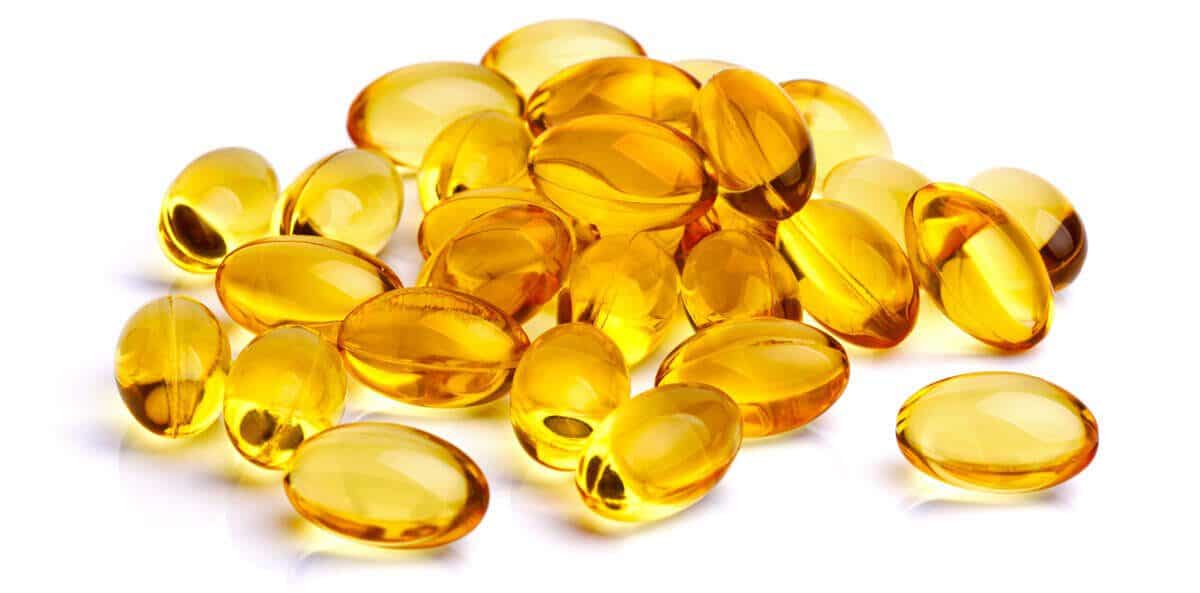
What's an Omega-3 Index And Why is it Important to Your Health?
Omega-3 fatty acids are essential and required for human life. While many know the importance of omega fatty acids as part of a healthy lifestyle, it hasn’t been clear how low amounts of fatty acids in the blood are also linked to all types of death including heart disease and cancer until now.
A recent analysis consisting of 17 perspective studies and consisting of more than 40,000 participants over 16 years has shown a 15-18% lowered risk of all causes of death based on higher polyunsaturated fatty acids (PUFAs) in the blood. It is important to detect early signs of omega-fatty acid deficiencies for supplement therapy to aid in reducing the incidence of disease and risk of premature death.
While the analysis does not show how polyunsaturated fatty acids (PUFAs) were consumed by each participant, it’s important to recognize the best sources. The best sources of PUFAs are found in sea life, mostly cold-water fish. Fish have the highest concentrations of PUFA’s as well as the best ratio of omega-3 EPA and DHA which reduces chronic inflammation—the root cause of most diseases.
Omega-3 fatty acids 3, 6 and 9 also contribute to multiple biological roles, such as influencing inflammation, reducing oxidative stress and presenting neuroprotection and cardiovascular protection. There are 100 billion neurons that make up your brain consisting of 60% PUFAs, and every cell in the human body has a cell membrane made of PUFAs. We are made entirely out of cells and cellular performance is key to maintaining optimal health.
Quality fish oil supplements have an excellent ratio of omega-3 EPA and DHA and come without the harmful toxins such as mercury found in fish. A study in the UK shows taking fish oil supplements lowers the risk of cardiovascular and all diseases across 427,000 participants. “The Heart and Soul” study shows that lower levels of whole blood EPA and DHA levels are associated with all causes of mortality and an accelerated rate of telomere shortening over a 5-year period. Accelerated telomere shortening is associated with a shorter lifespan.
We’re all looking for the lifestyle improvements we can make to not only maintain but improve our health outcomes. According to this analysis, we can live a longer, fuller life with less disease by managing the omega-3 levels in our blood. Because omega-3s have a powerful influence on the health of every cell we have, we can expect to have more energy, vitality, and quality of life to continue to do the things we love longer.

References:
1. https://www.nutraceuticalsworld.com/contents/view_breaking-news/2021-04-23/study-finds-omega-3-index-is-strong-risk-predictor-of-premature-death
2. https://pubmed.ncbi.nlm.nih.gov/12442909/
3. https://pubmed.ncbi.nlm.nih.gov/32131999/
4. https://www.ncbi.nlm.nih.gov/pmc/articles/PMC3058601/ -

Conquer Chronic Inflammation At The Source
Chronic inflammatory-related diseases are the most significant cause of death in the world today. While this is a startling statistic, you don’t have to suffer. There are many critical lifestyle-related changes you can quickly and easily implement to help reduce the harmful effects of chronic inflammation on your body. Among these are a healthy diet, regular exercise and anti-inflammatory supplements in your daily routine.
TriVita’s Anti-Inflammatory Wellness Regimen includes three science-backed supplements that have been shown to reduce some of the damaging causes and effects of chronic inflammation on the body.
Nopalea, Trans-Resveratrol and Omega3 Prime are a triple threat!

Nopalea benefits:
1. Lowers elevated, at-risk levels of C-reactive protein, a marker for inflammation
2. Improves joint mobility, range of motion and flexibility in the neck, back and joints
3. Less reliance on pain medication
Trans-Resveratrol benefits:
1. Helps with blood flow by keeping arteries and veins open to promote a well-functioning cardio system and healthy blood pressure
2. Helpful as an anti-viral and has shown a capacity to control fungal, bacterial and viral infections
3. A multi-tasker, helping with heart health, brain health, anti-viral, anti-aging and more, to help maintain optimal health and longevity
Omega3 Prime benefits:
1. Anti-inflammatory properties help to relieve joint discomfort and reduce symptoms associated with inflammation
2. Supports healthy blood pressure and reduces the risk of heart problems
3. Protects against cognitive declineChronic inflammation is a real, modern-world problem. Give yourself the best chance of conquering the chronic inflammation raging inside your body. The science and education about TriVita’s products are available to help you on your wellness journey!
References:
1. https://www.ncbi.nlm.nih.gov/books/NBK493173/
2. https://www.scripps.org/news_items/4232-six-keys-to-reducing-inflammation
3. https://www.ncbi.nlm.nih.gov/pmc/articles/PMC7734066/
4. https://pubmed.ncbi.nlm.nih.gov/28900017/
5. https://www.ncbi.nlm.nih.gov/pmc/articles/PMC7139620/ -
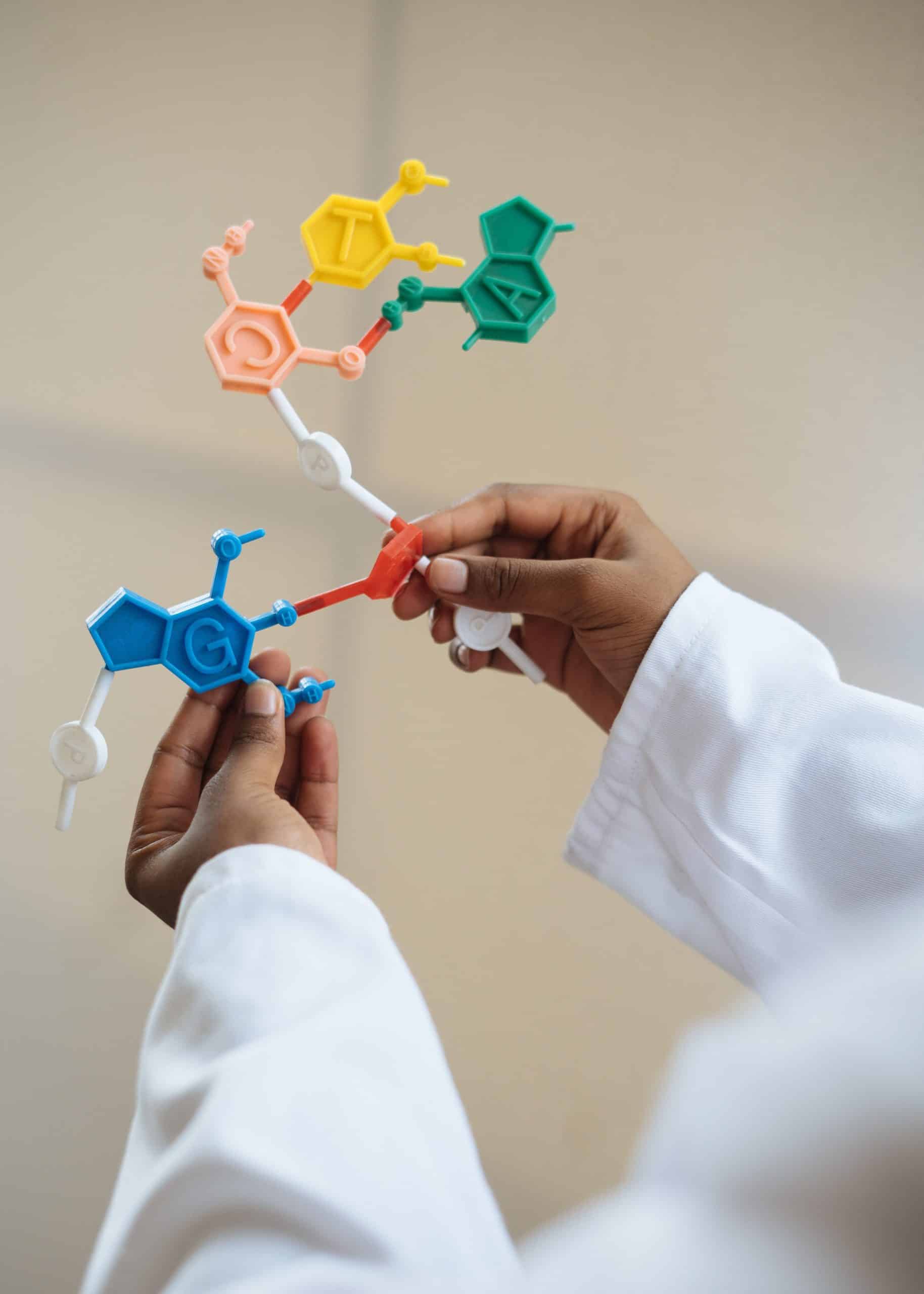
The "Miracle Molecule" For Immune & Brain Health!
During the past two decades, nitric oxide (NO) has been recognized as one of the most versatile players in the immune system. It’s involved in the pathogenesis and control of infectious diseases, tumors, autoimmune processes and chronic degenerative diseases.
Nitric oxide plays many important roles in the immune system. It’s produced in high amounts from specialized immune system cells called macrophages. Following bacterial infection, for example, the body produces chemicals known as cytokines which activate the cells of the immune system, including macrophages, and help guide them to the site of infection. The high amounts of nitric oxide produced by the macrophages are toxic to the bacteria and play an important role in their destruction. The production of nitric oxide in this way also helps protect against other types of infection, including viruses and parasites. In fighting off bacteria and diseases, nitric oxide helps the immune system keep our bodies healthy.
Nitric oxide, because it promotes healthy blood flow, including to the brain, has cognitive benefits as well. Alzheimer’s disease has also been linked to nitric oxide decline. One out of every eight baby boomers will get Alzheimer’s disease after they turn 65 years old; at age 85, that risk grows to one in two. As we age, this becomes even more critical. This is why healthy circulation and blood flow are so important. We want to be able to give our aging selves the best chance to live life to the fullest, and with more information at our fingertips than ever before, we have the tools to flourish as we age.
-

Nitric Oxide Keeps Your Blood Flowing

There is so much noise out there about stress and bad news leading to high blood pressure, it’s important to keep an eye on our own. High blood pressure occurs when the force of your blood pushing against the walls of your arteries is consistently too high. High blood pressure can lead to various health issues, such as heart and kidney problems. Consuming nitrates has been shown to help blood pressure because your body converts the nitrates to nitric oxide, which then causes blood vessels to relax and dilate, resulting in lower blood pressure. Various studies have shown nitrates help lower blood pressure by increasing the production of nitric oxide. Additionally, it has been thought people with high blood pressure have an impaired ability to produce nitric oxide.
Nitric oxide is necessary for healthy blood flow.
Healthy blood flow is essential for the heart, brain and all of our other organs. It also helps promote endurance, soothes sore muscles and can even help with healthy aging. Nitric oxide is synthesized and released into the endothelial cells, which is a cell layer lining all blood vessels, with the help of nitric oxide synthases that convert arginine into citrulline which helps produce nitric oxide in the process. We need to do what we can to stay away from stress, toxic environments and bad foods. But we also need a good level of nitric oxide, for a balanced, healthy body that will serve us well as we go through our happy lives with our families.

-

The Sky is the Limit with Optimal Levels of Nitric Oxide
Written by Paul Bernitt, DHH
Director of Clinical and Wellness ServicesNitric oxide is a gas produced by the body and it is produced by almost all human cells. It is made naturally in our bodies and plays a vital role in signaling between cells, neurotransmission and immune response, to name just a few. The most widely-known function of nitric oxide is its ability to send a signal to the endothelial lining of our arteries to expand and contract, which allows us to maintain vital blood flow rich in oxygen and nutrients throughout our bodies. This molecule has a half-life of less than a second so we must produce enough to prevent life-threatening consequences as we age. Because of nitric oxide’s systemic effect, it is important to understand what this miracle molecule is and how to maintain and improve the body’s ability to produce it throughout our lifetime.
Nitric oxide was brought to worldwide attention in 1988 when Dr. Robert Furchgott, Dr. Louis Ignarro and Dr. Ferid Murad won the Nobel prize for medicine by discovering nitric oxide as a signaling molecule in the cardiovascular system. Since then, there have been almost 175,000 scientific papers written about nitric oxide which have shown many other benefits of this vital molecule. It has been said that this molecule may be the most important one in the human body because of its role, not only in the cardiovascular system but also in its involvement in nerve impulses from cell to cell in every tissue throughout the body.
We live in a world where heart disease continues to be the number one cause of death. In most cases, heart disease has more to do with the plumbing, such as damaged arteries, than the heart itself. In healthy arteries, nitric oxide signals the vasodilation (relaxation) response of arteries. Vasodilation increases blood flow, increases oxygen in the blood, and modulates blood pressure. Because nitric oxide is an electron donor, this miracle molecule is cardio-protective as it enhances and maintains arterial elasticity through its anti-oxidant effects. In unhealthy arteries, vasodilation is compromised due to damage caused by years of uncontrolled elevated blood pressure, high lipids and glucose in the blood and calcified plaque buildup in the arterial lining. Instead of the heart having smooth, flexible arteries to pump blood, the heart has to supply blood through narrow stiff arteries leading to serious cardiovascular conditions as we age.
This molecule has also been shown to improve insulin sensitivity which reduces diabetes complications and is known to improve other hormone functions in the body. When we become insulin resistant, our cells become less permeable, which limits the ability of glucose to be converted to energy and increases toxicity. When glucose cannot be efficiently converted into energy, the levels of glucose in the blood rise and are converted into fat. High levels of glucose in the blood and obesity are significant antagonists to nitric oxide production.
One of the most significant concerns in modern society is the proliferation of harmful viruses. What many people do not know is that nitric oxide provides a protective immune response by its involvement with inhibiting virus replication. The immune system has a better chance of fighting off the symptoms associated with viruses and other foreign invaders if nitric oxide blocks virus replication.
Healthy nitric oxide levels systemically influence many functions of the body. Nitric oxide insufficiency can spawn a wide variety of symptoms and diseases caused by pathogenesis, which can lead to infectious diseases, tumors, autoimmune processes and chronic degenerative diseases as we age. Low nitric oxide levels lead to increased sympathetic tone (constriction) which negatively influences blood flow, blood pressure and vasodilation. The immune response to stop the replication of harmful pathogens and viruses and other foreign invaders also diminishes. As nitric oxide production continues to diminish so does motivation and stamina for activity.
Nitric oxide is the neurotransmitter of bronchodilator nerves in human airways and counteracts bronchoconstriction. Nitric oxide increases the lungs’ ability to deliver oxygen throughout the body by signaling the nerves to dilate. When the physical demand of the body is increased through activity, nitric oxide is produced to stimulate vasodilation and a higher respiration rate. We can live a month without food and 3 days without water, but we have only minutes to live without oxygen. All of our cells require oxygen and the level of nitric oxide in the blood determines the amount of oxygen our cells can receive by dilating the arteries, signaling the lungs to increase respiration and signaling the heart to beat faster.
New studies show that the reduction of nitric oxide production due to arterial stress may be contributing to premature aging. Nitric oxide has been shown to inhibit premature telomere shortening. Telomeres are protective caps at the ends of the DNA molecules that make up our chromosomes. Much like the plastic tips on the ends of shoelaces they protect the ends of chromosomes from damage. Each time a cell divides, the telomere gets shorter, soon it becomes so short that the cell can no longer divide to create new healthy cells. Science is discovering that nitric oxide reacts to tissue-derived oxygen radicals and by doing so reduces oxidative stress which can lead to the premature death of cells and shorter telomeres. The less oxidative stress we have, the longer our telomeres can be and the better our cells can reproduce and work as they should.Age is a major contributor to reducing nitric oxide production. As we age we produce less nitric oxide. The aging process, due to stress and damage to our arteries, contributes to less endothelial sensitivity and the thickening of our arterial lining. All of this, plus chronic inflammation, plaque buildup, stiffening of arteries, calcification, and eventually rupture of plaque leads to heart attacks and strokes. By age 40, most Americans only produce 50% of the nitric oxide as compared to their 20’s, by age 50, 35%, and by 60+ only 15%.
For more information about Nitric Oxide, please consider these references:
https://pubmed.ncbi.nlm.nih.gov/11994742
https://pubmed.ncbi.nlm.nih.gov/18341206
https://www.nature.com/articles/ni1001-907
https://www.ncbi.nlm.nih.gov/pmc/articles/PMC1573233
https://pubmed.ncbi.nlm.nih.gov/23075551
https://www.ahajournals.org/doi/10.1161/01.HYP.27.4.849
https://www.ncbi.nlm.nih.gov/pmc/articles/PMC2258411
https://www.researchgate.net/publication/11944012_Mechanisms_of_the_Antioxidant_Effects_of_Nitric_Oxide
https://pubmed.ncbi.nlm.nih.gov/27872324
https://www.ncbi.nlm.nih.gov/pmc/articles/PMC3838201
https://www.clevelandheartlab.com/wp-content/uploads/2018/11/CHL-D070-AUG2018-ADMA-SDMA-Practitioner-One-Pager.pdf
https://pubmed.ncbi.nlm.nih.gov/18090659
https://pubmed.ncbi.nlm.nih.gov/7546629
https://www.ahajournals.org/doi/full/10.1161/01.RES.87.7.540
https://www.ncbi.nlm.nih.gov/pmc/articles/PMC3390088/#b56
https://pubmed.ncbi.nlm.nih.gov/33296498
https://pubmed.ncbi.nlm.nih.gov/15650225
https://journals.asm.org/doi/10.1128/JVI.79.3.1966-1969.2005
https://dermnetnz.org/topics/horse-chestnut-extract
https://pubmed.ncbi.nlm.nih.gov/23152216
https://www.sciencedirect.com/science/article/pii/S0102695X15001003
https://pubmed.ncbi.nlm.nih.gov/8569363/https://ods.od.nih.gov/factsheets/Magnesium-HealthProfessional/ -
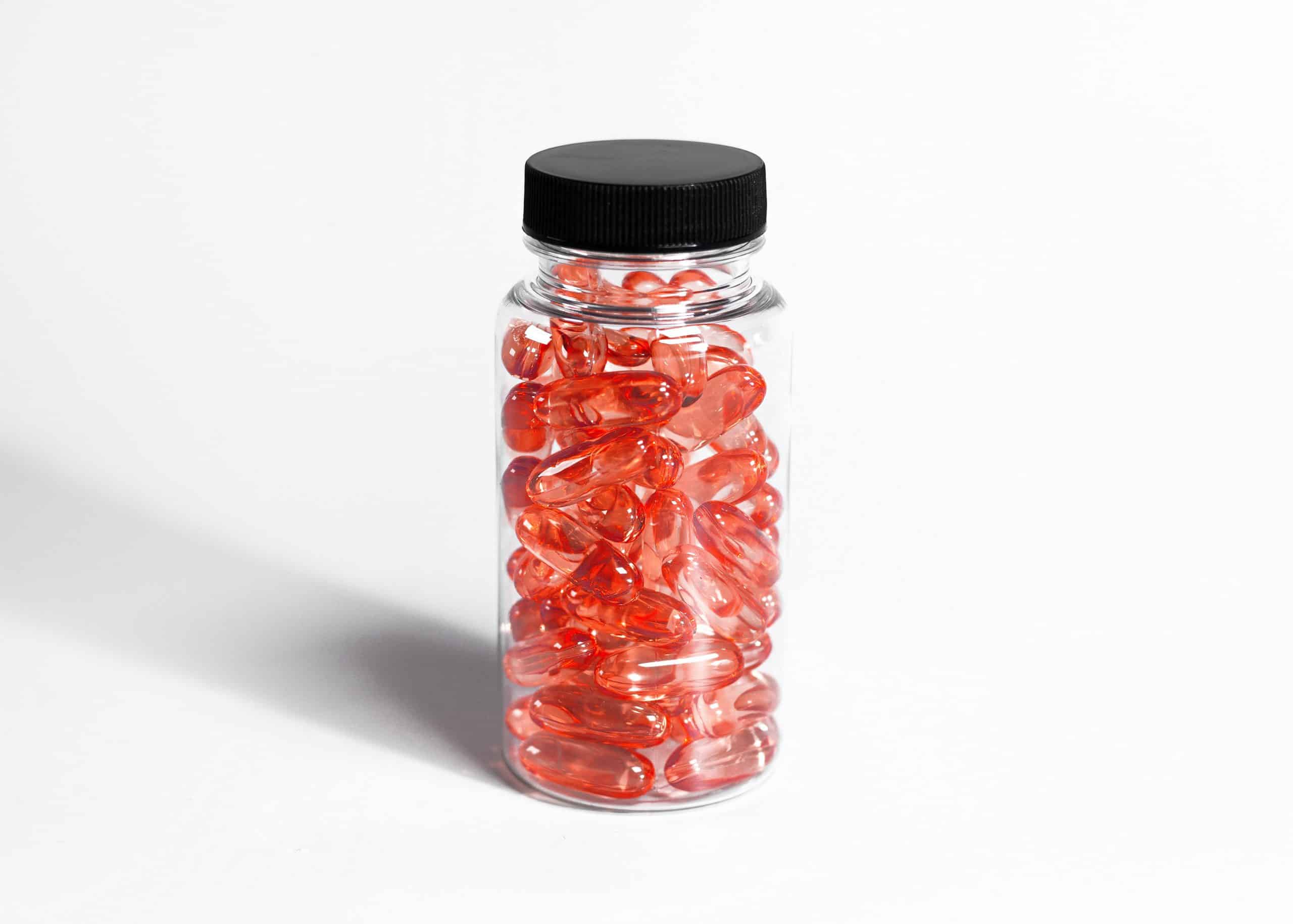
The Power of B Vitamins
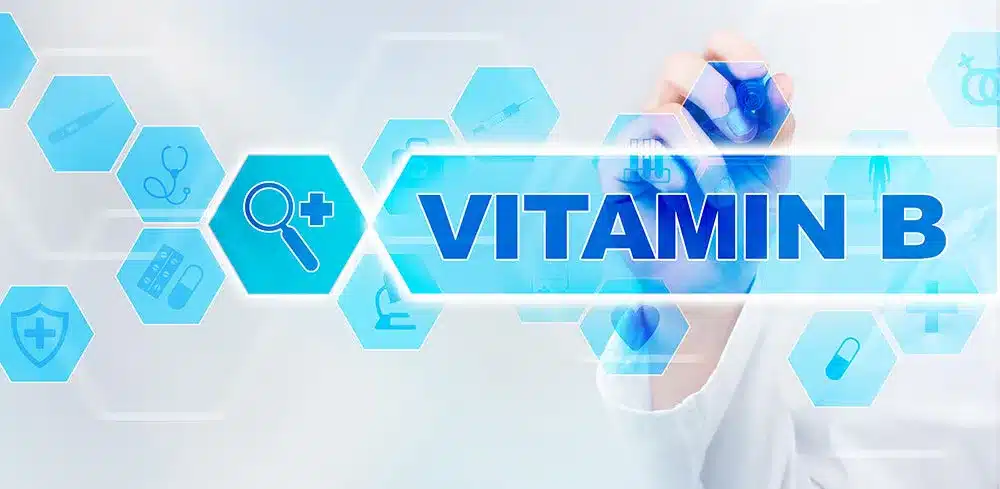
Vitamins A, B, C and D are all great for you individually, but the combination of vitamins and other micronutrients work together to create a synergistically healthier outcome. Other micronutrients include minerals, amino acids, enzymes and antioxidants. One example of how micronutrients work together is how calcium, magnesium, vitamin D and vitamin K2 work together for building strong healthy bones. There are many other examples of the synergistic benefits of micronutrients working together. Today, let’s dive into the synergistic benefits of how eight individual B vitamins work together to maximize energy and cellular health.
According to the National Institute of Health, B vitamins are primarily responsible for helping your metabolism work properly. They are also are dependent on a healthy microbiota in the gut. This shows not only the importance of the synergy of micronutrients working together but also how they rely on gut health.1 Your metabolism involves the chemical processes needed for life, such as making cells, creating energy from the food you eat and breaking down bi-products of energy and waste matter. B vitamins and how they interact with the body are essential to our overall health.
B vitamins are water-soluble, which means they dissolve in water inside your body and are then easily absorbed into tissue for immediate use. Because B vitamins are so easily absorbed and used, they cannot be stored like fat-soluble vitamins. For this reason, it is important to consume healthy, fresh, unprocessed foods rich in B vitamins every day. This will also assist healthy microbiota in the gut. Combining foods rich in B vitamins with a healthy gut will maximize optimal digestion and metabolism of vital energy throughout the body. Primary sources of B vitamins in animal products consist of fish, meat, poultry, eggs and dairy products and can also be obtained from plant sources such as green leafy vegetables, beans and peas.
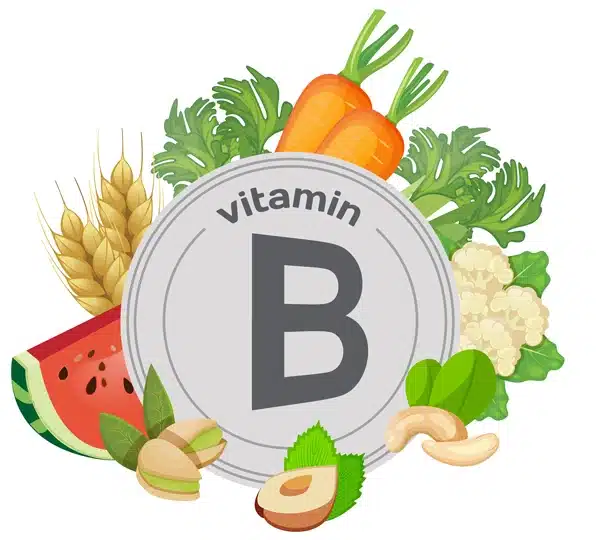
B Vitamins and their Benefits
B1 Thiamine: Needed for carbohydrate, fat and protein metabolism, blood sugar regulation as well as nerve and muscle function.2
B2 Riboflavin: Needed for carbohydrate metabolism, red blood cell growth and development and cellular function.3
B3 Niacin: Converts food into energy, creates and repairs DNA, healthy cholesterol levels, and maintains cognitive function.4
B5 Pantothenic Acid: Especially important for breaking down fats and metabolizing carbohydrates and protein while supporting muscle endurance, nerve function and cognitive function.5
B6 Pyridoxine: Cardiovascular, brain and nerve support as well as protein metabolism.6
B7 Biotin: Converts carbohydrates, fats and proteins into energy and supports skin, hair and nails.7
B9 Folic Acid: Protein metabolism, needed for making DNA and other genetic material for cell replication and important during pregnancy.8
B12 Cobalamin: Protein and fat metabolism, cardiovascular support nerve fiber support, cognitive support, formation of hemoglobin and prevention of anemia.9
The 8 B vitamins work together and are involved in many of the vital functions of the body. Ensuring you are getting adequate amounts of B vitamins daily will enhance overall energy levels and essential vital bodily functions in every stage of life. Cheers to you living with greater energy, vitality and quality of life.
About Paul Bernitt, DHH, Director of Clinical and Wellness Services at TriVita

Paul Bernitt is a Board-Certified Doctor of Holistic Health by the American Naturopathic Medical Certification Board. He is also a Master Herbalist, a Holistic Wellness Practitioner, Doctor of Divinity, and has a degree in Mind-Body Transformational Psychology. Additionally, Paul is certified in Clinical Hypnotherapy, Holistic Nutrition, Bioenergetics, and Life Coaching.
Paul’s mission is to end as much needless suffering as possible by helping people discover hope, health, and healing. He has helped thousands of people experience the value of optimal health and wellness so they can live their purpose with greater energy, vitality, and quality of life mentally, physically, spiritually, emotionally, and environmentally.
References
1. Metabolism of Dietary and Microbial Vitamin B Family in the Regulation of Host Immunity – PubMed (nih.gov)
2. Thiamin – Consumer (nih.gov)
3. Riboflavin – Consumer (nih.gov)
4. Niacin – Consumer (nih.gov)
5. Vitamin B6 – Consumer (nih.gov)
6. Vitamin B6 – Consumer (nih.gov)
7. Biotin – Consumer (nih.gov)
8. Folate – Consumer (nih.gov)
9. VitaminB12-Consumer.pdf (nih.gov), Vitamin B12, cognition, and brain MRI measures | Neurology,
-

Antiviral Benefits of Trans-resveratrol
Resveratrol is a type of natural phenol and a phytoalexin produced by red grapes, peanuts and other plants. Trans-resveratrol is the active ingredient in resveratrol and is widely used in supplements.
Trans-resveratrol is great at multitasking. It can help with heart health, brain health, anti-aging and has antiviral benefits. In recent years, extensive research on resveratrol has been carried out, demonstrating its capacity to prevent a wide variety of conditions, including cardiovascular diseases and cancer, and to control fungal, bacterial and viral infections. Studies suggest that the chemical agent in resveratrol interferes with infection by altering cellular pathways rather than acting directly against the virus itself.
The antiviral effects of resveratrol have been demonstrated in a number of pathogenic human and animal viruses, including influenza, Epstein-Barr and various respiratory viruses. The resveratrol inhibits viral protein synthesis and various transcription and signaling pathways and viral-related gene expressions.
There still are more studies to be done on resveratrol, but evidence gathered so far shows high antiviral potential. Resveratrol has shown to be a potent antiviral molecule against various types of DNA and RNA viruses.
References
-
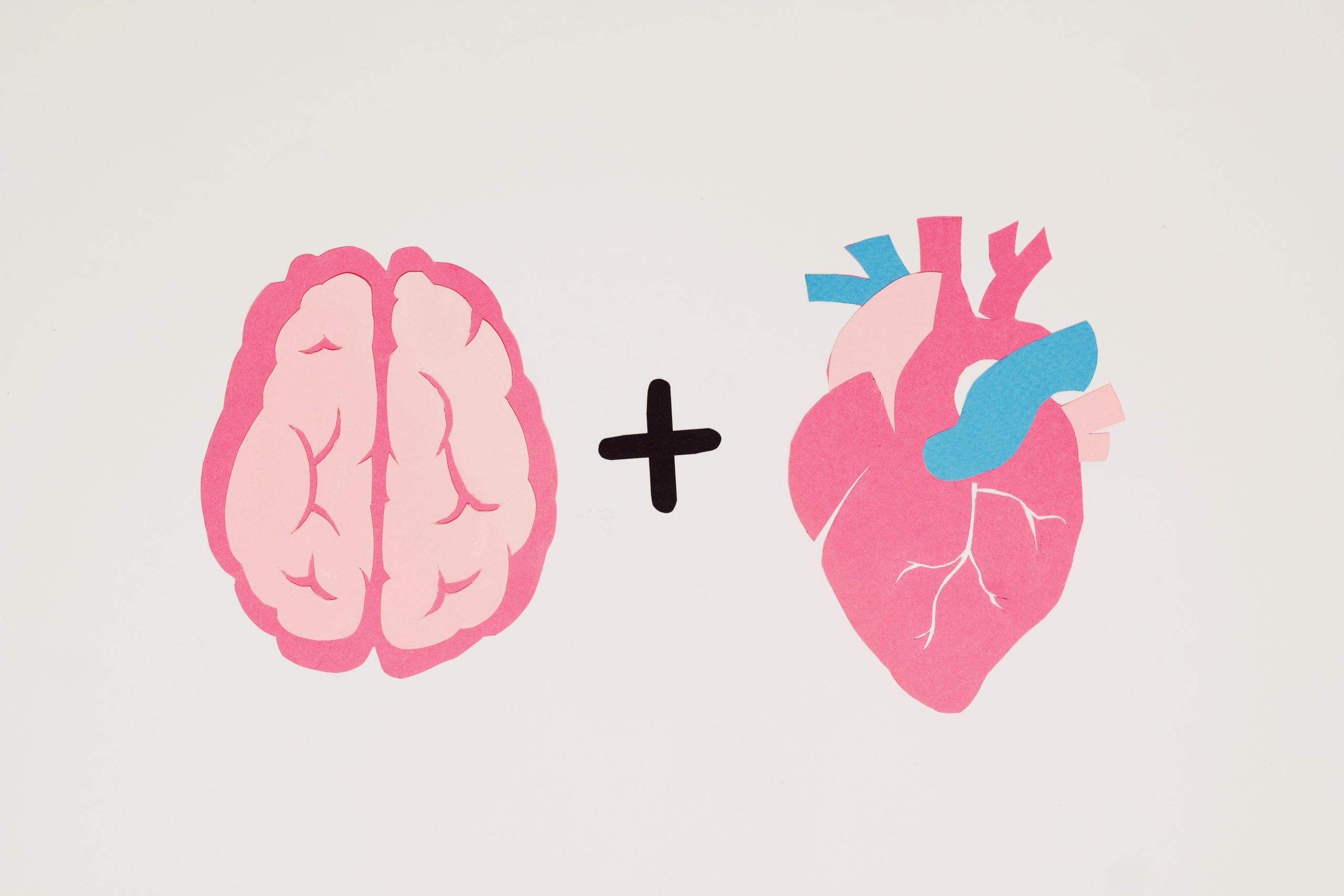
Brain Health & Trans-resveratrol
Growing older is the largest risk factor for neurodegenerative disease, commonly known as brain health. Included in that group is Alzheimer’s, Huntington’s and Parkinson’s diseases along with ALS. Some of these are passed down in our genes, but there are ways to at least slow down the process. The good news is that resveratrol has shown that it may help with this. Resveratrol is a type of natural phenol and a phytoalexin produced by red grapes, peanuts and other plants. Trans-resveratrol is the active ingredient in resveratrol and is widely used in supplements. Both have beneficial effects on the human brain. Clinical trials have demonstrated that resveratrol reduces levels of amyloid-beta in cerebrospinal fluid and improves cognitive function in people with Alzheimer’s disease.

Clinical evidence derived from randomized clinical trials suggests that resveratrol can help with memory loss by improving cerebral blood flow, cerebrospinal fluid level and performance in some cognitive tests.
As the general population grows older, hundreds of millions of people worldwide are affected by neurological disorders. There are many clinical studies dealing with brain health and resveratrol has shown to possess ingredients that can help slow down, and in some cases, prevent neurological disorders, improve memory, as well as slow down the aging process.
Resveratrol may contribute to brain aging reversal by as much as ten years.
References
1. https://pediaa.com/what-is-the-difference-between-resveratrol-and-trans-resveratrol/
2. https://www.ncbi.nlm.nih.gov/pmc/articles/PMC5339301/
3. https://www.ncbi.nlm.nih.gov/pmc/articles/PMC6657254/
4. https://www.nutraingredients.com › Article › 2020/04/08 -

Heart Health & Trans-resveratrol
Heart disease is the leading cause of death in the United States. Heart disease includes various disorders of the heart itself or the blood vessels. It could be coronary artery disease, deep vein thrombosis, congenital heart disease or many others. Heart failure is defined as the inability to pump enough blood to the rest of the body. They all can be classified as a major medical concern and need attention to help slow down the spread or treat the symptoms as best as possible.
Resveratrol is a type of natural phenol and a phytoalexin produced by red grapes, peanuts and other plants. Trans-resveratrol is the active ingredient in resveratrol and is widely used in supplements.
Clinical trials using trans-resveratrol have shown that it may help. Resveratrol could be linked to a lower risk of inflammation and blood clotting, which can lower the risk of heart disease. Resveratrol is also known as a polyphenolic compound and has antioxidant and anti-inflammatory properties. These also help with cardiovascular health. The polyphenols are also present in grapes and red wine, which contributed to the “French Paradox” in the 1990s that found that red wine in moderation may be good for you.
Trans-resveratrol has several beneficial effects and can act at different levels such as cellular signals, enzymatic processes, apoptosis and gene expression. All of these together, along with the ability to flow freely through the bloodstream, have been shown to have positive effects fighting different cardiovascular diseases.

References
https://pediaa.com/what-is-the-difference-between-resveratrol-and-trans-resveratrol/
https://www.ncbi.nlm.nih.gov/pmc/articles/PMC4882663/
https://www.intechopen.com/chapters/62439
-

How to Improve Brain “Fitness”
By Sandra Bond Chapman, Ph.D. We know the physical changes that aging brings: graying hair, wrinkles and a tendency to gain weight. Less well understood, but more important to our ability to live long, healthy lives, are age-related changes in our brains. According to a recent survey by AARP (American Association of Retired Persons), staying mentally sharp is important to 93% of Americans, but few know how to maintain or improve brain health. Until recently, cognitive (brain function) losses in healthy adults were viewed as an inevitable consequence of living longer. Since our life expectancy has increased steadily over the years, this caused alarm. Scientific research shows that cognitive aging is a natural pro cess that affects everyone, to varying degrees, with both positive and negative effects. But here is the good news: each of us has the ability to strengthen our brain function throughout our lives, and to prevent, slow or even reverse cognitive decline. That is, if we take the right steps, eliminate toxic routines and adopt healthy habits. For thousands of years, people have searched in vain for the Fountain of Youth to stay young. However, science is pointing the way to a different approach, which is to embrace the continued potential of our aging mind. We have tremendous power to strengthen and heal our brain’s health throughout life. Without brain health, we simply do not have health.
9 WAYS TO STAY SHARP
Whatever your stage in life, use these brain-healthy habits to strengthen brain systems and enhance brain “fitness”:
Get a good night’s sleep
Eight hours is optimal. It allows us to reset an exhausted brain engine, to consolidate learning of new information at higher levels of understanding and to derive “aha” moments. These “ahas” happen when we connect ideas in newer, more innovative ways.
Slow down to succeed
Working constantly without taking time to step back and reflect on actions hinders productivity and performance along with increasing stress. While it seems counterintuitive to increase mental energy by slowing the pace, try it; it works. Give weighty decisions and projects the time, reflection and contemplation they need.
Block out
Consciously filter extraneous information to focus on the task at hand. This technique has not only been shown to impact cognitive health but is also a sign of higher intellectual function. It may come as a surprise, but our current daily lifestyle habits—even some we believe are good for our brain such as the myth of multitasking—are toxic to good brain health.
Think at a deeper level
Instead of being bogged down in minute details, give information new meaning by absorbing it and relating it to your own experiences. Achieving a new perspective will inspire your brain to generate new ideas and solutions.
Enjoy aerobic physical activity
Exercise is one of the most important ways to increase blood flow to the areas of the brain crucial to memory and attention. In a recent study, our researchers at the Center for BrainHealth found that an hour of aerobic exercise three times a week significantly improved memory function of adults ages 57-75 within 12 weeks.
Eat right
Fill your plate with vegetables, fruit, nuts, fish, legumes and olive oil. Go easy with red meat, dairy products and sweets. This diet balance reduces disease of the blood vessels and arteries, which is a major contributing factor to dementia and mental decline. Deficiencies of the nutrients from a healthy diet can impair brain function and long-term brain health.
Manage medications effectively
Some medications—including certain anxiety or sleep drugs and antihistamines—can lead to mental fogginess. Regularly discuss and review medications that may affect brain function with your healthcare provider.
Reduce cardiovascular disease risk factors
Your heart and your brain are uniquely intertwined. Be sure to control high blood pressure and diabetes and stop smoking.
Connect socially
Social networks are positively related to higher cognitive performance. This article is intended for educational purposes only.
References:
http://www.aarp.org/about-aarp/press-center/info-01-2015/staying-sharp-brain-health-survey.html
http://journal.frontiersin.org/article/10.3389/fnagi.2013.00075/abstract
-

Gut Health: The Key To a Healthy Life
Modern medicine is learning what many traditional cultures knew all along—a healthy gut is critical for a healthy body.
There are two principal reasons for this—nutrients and immune health. Without the ability to process and assimilate key nutrients into the body, everything from brain function to muscle integrity suffers. A healthy gut digests everything we take in and grants access to these vital nutrients, which impact every cell in the body. Less obvious but equally critical is the role the gut plays in regulating the immune system and identifying friend from foe.
The digestive process is a bit of a mystery to most people. We know what goes in and what comes out—it’s what happens in between that turns everything from leaves of lettuce to bites of meat into fuel and essential building blocks for our bodies where many of us lack some details. The digestive system has five main functions: (1) breaking down food into usable nutrients; (2) absorbing nutrients; (3) keeping out invaders and identifying friend from foe; (4) regulating the immune system; and (5) eliminating waste.
Modern medicine is learning what many traditional cultures knew all along—a healthy gut is critical for a healthy body.
The process begins in the mouth with chewing, an under-appreciated part of digestion, which breaks food down into smaller pieces that would otherwise have to be broken down by chemical processes alone. Chewing also moistens and mixes the food with saliva. The first chemical breakdown of food also occurs in the mouth thanks to salivary amylase, an enzyme that begins breaking down carbohydrates.
Afterwards , food in the mouth is swallowed and travels down the esophagus to the stomach.The body requires both macro and micronutrients. There are three main types of macronutrients—carbohydrates, fats and proteins. “Carbs” come in simple forms such as sugars as well as complex forms, which are basically chains of sugars. Foods like rice, bread, potatoes and pasta are rapidly broken down to sugar and tend to spike blood sugar levels relatively quickly. Foods with more complex forms of carbohydrates, including most vegetables, are broken down more slowly and tend not to raise blood sugar very much. Still other carbohydrates cannot be broken down by our body and may pass through the upper part of the digestive system and into the colon, where they serve as food and fuel for the microbes living there.
The other two main macronutrients also serve key functions. A substantial portion of the human body consists of protein, and amino acids serve as the building blocks of protein to enhance our bodily functions and make muscle. Fats are equally important. They are the most dense source of calories for the body, yielding 9 calories/gram compared to 4 calories/gram for protein and carbohydrates; they serve as reservoirs of energy storage for the body and as the key components of our cell membranes. They are also critical for maintaining cell structural integrity.

Once food reaches the stomach, it’s mixed with fluids and stomach acid. Stomach acid is in actuality hydrochloric acid, a strong chemical acid, but thanks to mucus and a specialized lining, the stomach remains protected, enabling it to serve as a holding tank that regulates the delivery of food to the intestines. Acid is vitally important to the breakdown of food, especially proteins, which are broken into smaller fragments that can be further digested in the intestines.
Two other vital organs that feed into the upper intestines and perform critical digestive functions are the liver and the pancreas. As the metabolic powerhouse of the body, the liver produces many important proteins and detoxifies chemicals and hormones and excretes them into the bile. Bile is concentrated in the gallbladder, which pumps it into the intestine when stimulated by food. Bile allows the liver to rid the body of toxins and metabolic waste products and helps with the digestion of fats through emulsification, making them more soluble.
The pancreas plays a central role in both digestion and regulating metabolism through the production and secretion of insulin, along with other hormone-like molecules. The pancreatic fluids secreted into the intestines contain three different types of digestive enzymes—proteases, lipases and amylases. Proteases break down protein into smaller pieces and eventually into amino acids. Lipases break down fats into fatty acids and amylase breaks down starch into sugars. As such, it’s easy to assess the importance of digestive enzymes. However, disease and the aging process can limit production. When this happens, it can prove beneficial to add enzyme supplements to your diet on a regular basis.
Food from the stomach is fed into the small intestine, where the majority of nutrients are absorbed. It consists of three parts—in digestive order the duodenum, the jejunum and the ileum. The small intestines have many folds and are covered with multiple projections, called villi, which in turn are covered with microvilli that further increase the surface area to over 400 square feet.
Adequate breakdown of food and the health and integrity of the intestinal lining are both key to preserving health. In a healthy gut the lining is protected by intact membranes that form a tight seal to keep anything from seeping between the cells into the bloodstream. But a damaged or leaky lining allows protein fragments and other molecules that would normally remain in the gut to pass through and enter the bloodstream. And if the proteins, carbohydrates and fats are not fully broken down by stomach acid and enzymes before entering the bloodstream, the situation becomes even worse.
When digestion is incomplete due to a lack of stomach acid, deficiencies in digestive enzymes and insufficient bile or a microbiome that is out of balance, larger particles may get into the bloodstream.
Once these larger molecules that normally stay inside the gut reach the bloodstream, the immune system identifies them as foreign invaders and attacks by targeting antibodies and different types of immune cells against them. When the problem of incomplete digestion causes symptoms in the gastrointestinal (GI) tract itself, bloating, diarrhea, constipation or abdominal pain may occur. And when these fragments travel throughout the bloodstream, autoimmune problems such as certain types of arthritis or even thyroid problem issues occur.
Where Do Healthy Bacteria In The Gut Come From?
Babies are born without any bacteria in their gut; those born vaginally develop a wider variety of healthy normal bacteria sooner than babies born by Cesarean Section as the trip through the birth canal inoculates them with healthy bacteria from the mother. While the full adult microbiome does not usually get established until around age 4, children who have siblings, grow up with a dog, go to daycare and play outdoors are less likely to have certain types of health problems (such as asthma) and tend to have more complete and healthier microbiomes.
What Can Go Wrong?
Troubles with the GI system can occur anywhere along the way. Dry mouth and insufficient chewing can lead to swallowing problems, as well as issues breaking down food, since the body depends on the mechanical crushing action of chewing to increase the surface area of food and, in turn, to give the stomach acid, bile and enzymes a chance to act on that food.
If you have eaten a wide variety of live foods throughout your life and rarely if ever taken antibiotics, you may have a diverse and healthy population of bacteria in your system. However, the diversity of the microbiome may decrease as you age, leading to the theory that this may be an important factor in the development of different diseases and a loss of resilience with age. If you have taken antibiotics during your life, your gut bacteria may be even less complete. In these circumstances taking a probiotic supplement on a regular basis may enhance your overall health.
GERD – Acid Reflux

Food passes from the esophagus into the stomach through the LES (Lower Esophageal Sphincter) which acts like a valve, letting food into the stomach and preventing it from reentering the esophagus. However, when the LES fails to do its job, acid from the stomach or bile can back up into the esophagus, damaging the esophageal tissue and potentially causing burning pain or scarring.
Reversible factors that can cause or worsen Gerd:
- Caffeine
- Tobacco
- Alcohol
- Mint or Peppermint
- Obesity
- Certain Medications
Stomach Problems

Stomach problems stem from three main causes: infections with the bacteria Helicobacter pylori, medications and substances that damage the lining of the stomach and form substances that increase stomach acid. Mild to moderate stomach problems result in gastritis, damage to the surface of the stomach lining, while more serious problems result in ulceration. Stomach ulcers can form deep holes in the stomach lining and cause serious bleeding or even perforation. Helicobacter pylori infections can be identified with blood, stool or breath tests. The infection can be eliminated with a combination of antibiotics and other stomach medicines. Treating Helicobacter infections greatly increases the chance of healing the ulcer and helps to prevent recurrence.
Factors That Cause Stomach Ulcers:
Agent: Helicobacter Pylori Infection
Mechanism: Infiltrates stomach liningAgent: Aspirin/NSAID Medications
Mechanism: Directly damage stomach liningAgent: Alcohol
Mechanism: Directly damage stomach liningAgent: Caffeine
Mechanism: Increase stomach acid outputAgent: Tobacco
Mechanism: Increase stomach acid outputAchlorhydria – Problems With Too Little Stomach Acid
Insufficient stomach acid can also cause problems. Stomach acid helps break down food and to form a first line of defense against many organisms we ingest. Insufficient stomach acid, known as achlorhydria, not only results in poor digestion; it is also associated with lower absorption rates of certain nutrients such as calcium and with a condition called Pernicious Anemia, which occurs when intrinsic factor, an element produced in the stomach essential for the absorption of Vitamin B-12 production, is not made. This results in a severe Vitamin B-12 deficiency that can cause anemia, nerve damage and even cognitive decline.
Intestinal Problems
Digestion difficulties in the intestines can involve the small or the large bowel. The large bowel is called the colon. Celiac Disease is an autoimmune disorder involving the destruction of the lining of the first portion of the small bowel, which results from a reaction to gluten. In Celiac and many diseases that affect the bowel, the villi and microvilli are destroyed, leading to a loss of the ability to absorb nutrients. When this happens a variety of secondary problems can occur throughout the body due to a lack of these nutrients.
A healthy population of bacteria in the intestines is also critical for digestion, as these bacteria produce substances that nourish the cells that line the gut along with certain vitamins and other nutrients. If your microbiome (the organisms within your gut) is out of balance or declines in quality with age, probiotic supplements can be of value. In addition to a healthy population of bacteria, it’s also vital to have the right food to fuel them. Certain fibers can serve as prebiotics to fulfill this function. However, if your diet is lacking in healthy fibers, taking prebiotic supplements along with probiotics may improve the health and quality of your microbiome.
One of the most common bowel conditions is irritable bowel syndrome (IBS), which can cause pain, diarrhea and constipation. Stress plays a significant role in the communication between the nervous system and the bowel, and disorders such as IBS may improve with effective stress management techniques. Inflammatory bowel diseases (IBD) are more serious bowel disorders that can result in damage to the lining of large sections of the intestines and can lead to serious bleeding, obstruction and perforation. Diseases such as Crohn’s Disease and Ulcerative Colitis are inflammatory bowel diseases.
Functional Medicine Approach to Health the Gut
Functional Medicine uses an approach called 5R to heal the gut. 5R stands for:
Remove, Replace, Repopulate, Repair and Rebalance.
Different versions of this approach can be used to treat a variety of problems throughout the gut. Functional Medicine practitioners believe that treating gut problems is a critical element in healing not only GI problems but also a wide variety of problems throughout the body.
Remove

Removing refers to eliminating both pathogenic organisms such as parasites or excessive yeast as well as medicines or chemicals that damage either the gut itself or the health of the gut bacteria—the microbiome. Removing toxic chemicals and medicines primarily involves avoiding them to the extent possible. Sometimes special programs or supplements are used to help the body eliminate toxins.
Replace
Replace in the 5R treatment approach refers to replacing elements that may be missing such as stomach acid or digestive enzymes. It could also include replacing important elements missing in the diet such as vegetables or grains, which include prebiotic fibers that nourish and serve as food to maintain a healthy and diverse microbiome. If you aren’t getting enough beneficial ingredients from dietary sources, taking a prebiotic supplement may be of value.
Repopulate
Repopulate refers to reseeding the gut with healthy microbes. In the early 1900s, pioneering researcher Eli Metchnikoff puzzled over why certain people in the mountains of Bulgaria lived considerably longer than others. He found that these healthy mountain villagers were regularly drinking fermented yogurt, which contained a probiotic species that was a type of Lactobacillus. It clearly seemed to improve their health and also may have extended their lives. Based on Metchnikoff’s work, over the years others have done further work to enhance understanding. Modern research has shown that different beneficial bacteria have different positive effects in the body. These range from improving the symptoms of irritable bowel syndrome to lowering cholesterol and anxiety. These can come in foods like fermented yogurt, live foods such as sauerkraut and kimchee or from specific probiotic supplements. The most effective way to change the population of microbes in the colon is fecal microbial transplant [FMT], or stool transplant. When successful, this seems to result in a more significant and sustainable change in the microbial population. Fecal transplant is most commonly used for patients who have recurrent life-threatening colon infections with the bacteria Clostridium difficile, although a number of other conditions may also benefit.
Foods that may have prebiotic effects:

Asparagus, garlic, leeks, legumes, oats,
sea weed , onion, bananas, dandelion greens, barley, wheat bran, Jicama root, Jerusalem artichokesand artichokes.Repair
The Repair in the 5R approach refers to supplying important nutrients that help to improve the health of the cells lining the gut. This includes giving substances that can sustain and nourish the cells that line the stomach and intestines such as the amino acid glutamine as well as micronutrients like zinc, along with a spectrum of vitamins. When the stage has been set by removing harmful elements and repopulating the gut with healthy microbes, these healthy substances can help heal the lining of the intestines and make it less likely to be a leaky gut. This in turn can lead to improvements in health throughout the body.
Rebalance
Rebalance is the final phase of improving gut health. If the body is under sustained chronic stress, cortisol and other hormones change the environment in the bowel. This makes it more favorable for the unhealthy bacteria and less favorable for healthy species of bacteria and other microbes. Stress management, counseling and mind-body work such as MBSR (Mindfulness Based Stress Reduction), T’ai Chi and Yoga can help rebalance the autonomic nervous system and allow the body to develop a healthier level of gastrointestinal function.
5R Gut Healing Table – Examples
REMOVE
Agents to Change:
Remove gluten in Celiac Disease and other sensitive individuals; remove harmful parasites, excessive yeastand harmful bacteria species; remove toxic chemicals and unhelpful medicationsREPLACE
Agents to Change:
Stomach acid replacement; digestive enzyme replacement; bile salt replacement when deficient; providing prebiotic fiberProducts and Approaches of Value:
Digestive enzyme supplements; prebiotic dietary fibers; prebiotic supplementsREPOPULATE
Agents to Change:
Replace healthy microbesProducts and Approaches of Value:
Live foods such as live culture yogurt and sauerkraut; probiotic supplementsREPAIR
Agents to Change:
Provide essential compounds for the health of gut cellsProducts and Approaches of Value:
ZincREBALANCE
Agents to Change:
Stress reduction techniquesProducts and Approaches of Value:
T’ai Chi program; healing prayerConclusion
Understanding that gut health is a key factor in your overall health is an important step. It also helps to unravel numerous issues that arise at different stages of digestion. By understanding each step and what can go wrong, we can take measures to preserve and restore the health of the entire GI system. A Functional Medicine approach relies on a deep understanding of what promotes health and what it takes to nourish and heal the gut to promote system wide health. The combination of a healthy gut and a healthy diet can allow us to optimize our nutrition, which can contribute to optimal health in tissues throughout the body. While it’s obvious that gut health relates to issues of the digestive organs, less obvious but equally important is understanding the role a healthy gut plays in issues as diverse as the regulation of the immune system and the health of the brain.
To download a printable PDF copy of this special report, click the button below:
About Robert Sheeler, M.D.

Dr. Robert Sheeler is a Family Physician who spent a substantial part of his career at Mayo Clinic. During that time he served as the Medical Editor for the Mayo Clinic Health Letter, taught and developed curriculum in the medical school and chaired the NeuroPsychiatric Medicine group. In addition to Family Medicine, he is also certified in Functional Medicine through the Institute for Functional Medicine and as a sub-specialist in Headache Medicine through the United Council of Neurologic Sub-specialists. Dr. Sheeler is Board Certified in Urgent Care, Holistic-Integrative Medicine and Integrative Medicine as well. He has strong interests in nutrition, cooking, stress management
and lifestyle medicine and also practices and teaches Taiji [T’ai Chi] and Qigong.DR. SHEELER’S PERSONAL PHILOSOPHY
I believe that a balanced lifestyle and a diet rich in healthy anti-inflammatory natural foods can be of significant value in preserving and restoring health. Natural products often make more sense than pharmaceuticals, as they seem to alter biochemical pathways more gently rather than turning off whole systems our body naturally utilize.
A diet that contains diverse types of vegetables along with some fruits is often best to promote a diverse and healthy population of gut microorganisms. I try to eat 2 servings of fruit a day—usually fruits that do not raise blood sugar as much such as berries and apples and 5 servings of different types of vegetables a day along with healthy proteins and healthy types of fats such as olive oil, especially EVOO, avocado oil and coconut oil.
Beyond eating right, exercising and getting adequate sleep, I believe that meaningful relationships, community and spiritual connection are also of great value.
-

7 Super Foods For a Healthy Heart
By Christa Orecchio,
Clinical and Holistic NutritionistThere are lots of things we can do to keep our hearts healthy, and eating right is one of the most important. By including more of these everyday “super foods” into your diet, you’ll be on the right track.
Blueberries
They top the list as one of the most powerful disease-fighting foods. Blueberries contain anthocyanins, the antioxidant responsible for their dark blue color. These delicious jewels are also packed with fiber, Vitamin C and heart-healthy potassium. Add them regularly to yogurt, smoothies, trail mix, salads or just eat them by themselves.
Make sure to buy organic blueberries. The conventional, non-organic type are on the “dirty dozen” list: they are likely sprayed with pesticides that permeate the entire fruit due to the vulnerability of the skin.
Wild salmon (reference)
This cold-water fish is a great source of protein and packed with heart-healthy omega-3 fatty acids that work to slash inflammation. The American Heart Association advises eating salmon and other omega-3 rich foods twice a week for benefits that go beyond heart health. Buy wild-caught salmon to avoid the lack of nutrients and less than ideal “raising conditions” that can be found in some
farm-raised salmon.Oatmeal (reference)
Oats are a nourishing whole grain and a great source of vitamins, minerals and cholesterol-lowering fiber. Research shows that oats help lower cholesterol levels and keep you regular.
Try adding oats whenever you bake. Substitute oat flour for white or wheat flour in pancakes, muffins, quick breads, cookies and coffee cakes for an added dose of fiber. Or try oats in place of breadcrumbs in dishes such as meatloaf, meatballs or breading on poultry.

Almonds and Walnuts
These are two very healthy snack choices. They’re high in plant omega-3 fatty acids, Vitamin E, magnesium, folate, fiber, heart-favorable mono- and polyunsaturated fats and phytosterols.
Kale
Even stronger than spinach, kale is the powerhouse of the vegetable kingdom. Its rich, dark color comes from the multiple phytochemicals, vitamins, and minerals (especially folate and iron) that also fight depression and disease, promote heart health and help preserve eyesight. To top it off, kale is also the “king of calcium”: it delivers the highest absorbable form of calcium possible.
Flaxseed
Rich in omega-3 fatty acids, cancer-fighting lignans, phytoestrogens and fiber, this powerful seed is most effective when it is ground up and stored away from light, heat and air. Studies suggest that flaxseed lowers the risk of blood clots, stroke and irregular heartbeats. It may also help lower LDL “bad cholesterol” and triglycerides. Use it on top of salads or soup, in yogurt parfaits, smoothies or morning cereal.
Brown rice
Contains high levels of B-complex vitamins and magnesium, which nourish our central nervous system. Vitamin B-12 and Vitamin B-6 in particular protect against blood clots and atherosclerosis, or hardening of the arteries. Niacin (Vitamin B-3) helps increase HDL “good” cholesterol.
With only a few simple dietary additions (found in any grocery store), you will be well on your way to having more energy and taking care of that amazing heart that beats for you, every second of every single day.
-

Live the Life You Were Born to Live… with Gusto!
Remember the famous painting, Whistler’s Mother? It was painted by James Whistler in 1871. His mother was only 67 years old, yet she appears to be relegated to her rocking chair and not too happy.
Compare her to Armand Gendreau, a skydiver at age 101. And Johanna Quas, a gymnast at age 87. Or how about Dan Pellman, who set five world records at the Senior Olympics… at 100 years young.
Now that’s Vitality!
As you can see, some people are defying the ‘belief’ in aging. Of course, genetics play a role, but many experts are saying that our mental and emotional states – and lifestyle behavior – may be even more important to longevity.
And thanks to biotechnology and other medical advancements, scientists say we could live much longer than we ever thought possible. In fact, a 2015 article in Time magazine suggested that today’s babies will live more than 140 years.
Yes, there are rapid advances in medicine, neuroscience and synthetic biology beneath all of these longevity projections – which are truly amazing!
But what can you do, today, to make sure you live a happy, vital, energetic life like Armand, Johanna and Dan… and do it with gusto?
I mean, would you really want to live to 120 or more, if you couldn’t do all the things you love to do – and feel good doing them?
Sleep. Nutrition. Movement. Stress-free.
“But wait a minute,” you’re probably saying. That’s what I always hear. And you’d be right because your good health depends on how well YOU take care of your body, mind and spirit. It’s all about choice – or free-will.
One area of study that’s providing more understanding in the cause and prevention of losing our age-related vitality is the study of cognitive decline – decreasing brain function.
According to the World Health Organization, Alzheimer’s and other brain diseases will affect one out of every five people at some point in life.
Let that sink in for a moment. Consider yourself and four other people in a room, and one of you will likely be affected by a brain disease, like Alzheimer’s. That’s stunning.
I watched my mother go through the various stages of Dementia, and it’s not a pretty picture. As she slowly, then more rapidly, lost her memory. Toward the end, she didn’t even know who her five kids were. She recognized our faces and was thrilled to see us, but could not remember who we were to her.
However, there is a silver lining behind this dark, dreary cloud!
Decades of research is showing us that declining brain health and cognitive loss are NOT inevitable. You can continue to learn, reason, remember and adapt your thinking processes well into old age.
The research confirms that you can retain your mental sharpness, by incorporating healthy lifestyle behaviors that will become habits:
- Adjust what/how you eat
- Get enough exercise (move that body)
- Sleep, sleep, beautiful sleep
- Deal with life’s challenges, gracefully
- Nurture important relationships
You can become a cognitive fitness expert, if you become fully committed to living healthy behaviors until one day you’ll realize they’ve become a habit… it’s just how you live now.
As you feel better, stronger, more energetic – and your mind is sharp as a tack, life becomes a lot more fun, doesn’t it?
“The hero who can save you is in the mirror!”
Be the Hero in Your Story

At TriVita and also at the TriVita Clinic of Integrative Medicine, we believe that only you can make decisions, based on your inner beliefs about WHO you are.
Lasting changes come from inside – not from outside influences. Make your commitment to be healthy, happy and vibrant, based on your inner values and purpose.
Do you want to live a healthy, robust life to do the things you love to do? Or to be there for your family? Or maybe you want to be able to help others in some way that’s meaningful to you.
Whatever your WHY… it’s that reason that is big enough for you to be the hero in your story. We’re here to help you do that because we believe that wellness is your birthright.
When Diet & Exercise are Not Enough
Proper eating habits and exercise are absolutely essential to our bodies. But sometimes our bodies need a little extra help. That’s why there’s TriVita and the TriVita Clinic of Integrative Medicine in Scottsdale, Arizona.
This month, we’re focusing on brain-health supplements… and we have some amazing ones to help you age younger, feel better and live your amazing life full-out!
As I’m sure you’re aware, TriVita is the ONLY place you can find Alfred Libby’s original, patented formula for the ‘little pink pill’ that simply dissolves under your tongue… rushing into your bloodstream for faster absorption. (This is so important for folks with gastric issues because it bypasses the intestinal tract.)
Daily and consistent use of the Libby original, patented formula delivers 100% of the recommended, daily requirements for B12, B6 and B9.

Your body doesn’t store B12, but you need it every day. So you’ll want to make sure you include this in your other lifestyle habits… you’re worth it! We wash our bodies, brush our teeth and our hair, daily, right? We also must give our bodies the nutrients it needs (on the inside) every, single day to operate at optimum efficiency.
Of course, TriVita also offers two other brain-healthy supplements, NeuroShine (U.S. only) and Omega3 Prime that you’ll want to know about if you don’t already.
In closing…
I’d like to leave you with one of my favorite quotes from Ghandi: “Be the change you want to see in the world.”
I believe that we humans are much more powerful than we realize. If you can imagine it… you can achieve it.
Imagine health. Imagine vitality. Imagine love & peace. See it, feel it, live it… with intention.
And by all means… live with GUSTO!
Yours in joy,
Carolyn
PS: Don’t forget to grab a box or two of Alfred Libby’s Slow Dissolve B-12